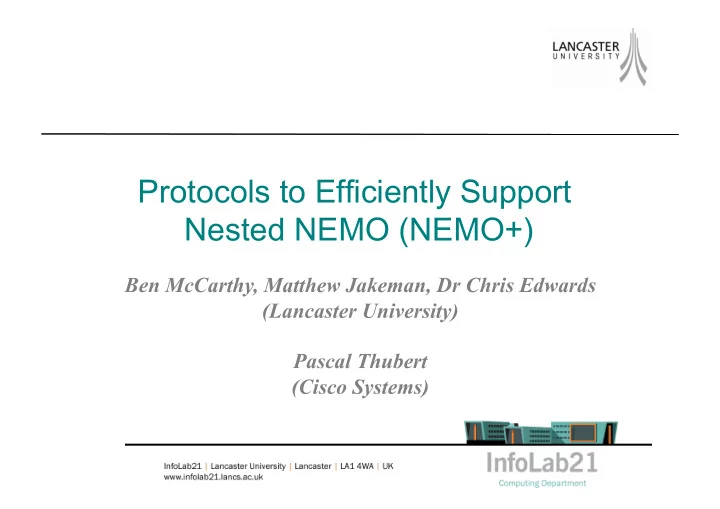

Protocols to Efficiently Support Nested NEMO (NEMO+) Ben McCarthy, Matthew Jakeman, Dr Chris Edwards (Lancaster University) Pascal Thubert (Cisco Systems)
Presentation Overview Presentation Overview Background: • Network Mobility (NEMO) • Overview • Nested NEMO • Overview • Scenarios Testing • Experimental Evaluation • Simulation Future Work • HA Communication Approach • MANET-Centric MANEMO
NEMO Basic Support NEMO Basic Support Based on MIPv6 • Support entire networks instead of just hosts Hosts connected to the Mobile Router unaware of underlying movement
Background Background Nested NEMO • Extremely inefficient routing when MRs interconnect • Packets subjected to “Pinball Routing” • Multiple layers of tunnelling • Internal communication with Nested NEMO must first travel via HAs • Localised movement unnecessarily registered with HA
NEMO+ Protocols NEMO+ Protocols Protocols to efficiently support Nested NEMO networks: • Tree Discovery (TD) • Network In Node Advertisement (NINA) • Reverse Routing Header (RRH) Leverage existing transfer that NEMO MR carries out • MR presents itself to the AR as individual host
Tree Discovery (TD) Tree Discovery (TD) IPv6 Router Advs augmented with Tree Info Option (RA+TIO) Helps MR decide which tree to connect to. Helps avoid loop formation RA+TIO carries info such as: • If top level router has Internet connection • Tree depth • Tree ID
Network In Node Advertisement (NINA) Network In Node Advertisement (NINA) Performed once MR has connected to tree NINA = IPv6 NA + Network In Node Option Advertises availability or loss of routes to MNPs up the tree
Reverse Routing Header (RRH) Reverse Routing Header (RRH) Added to packets leaving / going to a Nested NEMO Records the CoA of the Top Level MR • Also designed to record the path through the Nested NEMO if NINA is not present Ensures packets leave Nested NEMO and travel directly to the appropriate HA. • Removes tunnel nesting
NEMO+ Implementations NEMO+ Implementations 2 separate implementations • Linux (Kernel version 2.6.22) • 2Ghz CPU, 512MB RAM • Cisco IOS • Cisco 3200 Mobile Access Routers (MARs) Evaluation testbed comprised of both implementations • 2 HAs • 4 MRs • Predefined set of movements
Preliminary Results Preliminary Results Experimental evaluation testing consisted of roaming an MR across a testbed of four MRs and two HAs Comparative measurements were recorded for both NEMO BS and NEMO + in each testbed configuration. • Highlights performance benefits attained by removing Nested Tunneling and Pinball Route Simulation • OMNETT++ simulation runs
Future Work Future Work Integrate TD & NINA into a HA communication approach (UMA) • Supersedes RRH Support MANET routing protocol. • Different requirements: • NEMO-Centric: packets principally transmitted to nodes in the Internet • MANET-Centric: inter -communication between nodes as important
Questions? Questions?
Recommend
More recommend